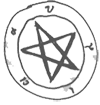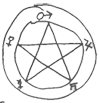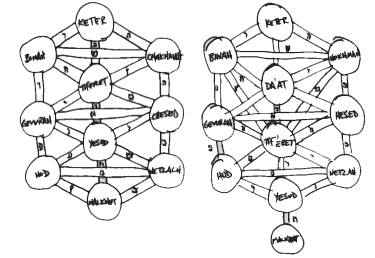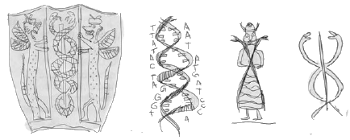1994
January 24:
Dean turns fifteen today. A week ago he helped me take out a spirit haunting a grocery owned by an Indian family in Erie, Pennsylvania. It was like any other spirit —you find the remains, you salt, you burn. But also it wasn’t. I’m learning that all spirits have some things in common, but it matters who they’re haunting. It matters what their traditions were when they were alive. Have been reading about Indian mythology. Gods upon gods, thousand of them, and each of them has attendant monsters and demons. Some of the ones that keep popping up, not so much mythology as folklore, are pishacha and acheri.

Pishacha eat human flesh and are supposed to be the sons of anger. They haunt cemeteries and places where cremations have taken place. They can change their shape, and in some stories they can also become invisible. Sometimes they attack and eat their victims, other times they possess them and drive them insane. I’m reminded of the unnamed demon in the Testament of Solomon who creeps “beside the men who pass along among the tombs, and in untimely season I assume the form of the dead; and if I catch any one, I at once destroy him with my sword. But if I cannot destroy him, I cause him to be possessed with a demon.”

Acheri is a demon that disguises itself as a little girl. From Indian folk tradition. Acheri are said to inhabit the mountains and murder travelers who are taken by its helpless guise. A protection against them is to wear a red thread around the neck (this was also said to protect small children against sorcery in some European countries).
Red thread: Kabbalah? According to the rabbis, there’s no mention in the Torah or Talmud about red strings, also no mention in written Kabbalah. But an old folk superstition states that tying a red string around the body is a segulah, a protective act. Some Orthodox Jews tie red strings on the cribs of infants to ward off evil spirits or the evil eye. Scholarly Jewish tradition considers the red string a superstition that veers dangerously close to impiety, even idol-worship.
Sefer Yetzirah: Everything derived from the Word, the creation of language, from which comes every aspect of physical world. Seven pairs of contrasts:
There were formed seven double letters, Beth, Gimel, Daleth, Kaph, Pe, Resh, Tau, each has two voices, either aspirated or softened. These are the foundations of Life, Peace, Riches, Beauty or Reputation, Wisdom, Fruitfulness, and power. These are double, because their opposites take part in life; opposed to Life is Death; to Peace, War; to Riches, Poverty; to Beauty or Reputations, Deformity or Disrepute; to Wisdon, Ignorance; to Fruitfulness, Sterility; to Power, Slavery.
No good, no evil. The way a man lives his life in relationship to natural and divine order dictates whether he will perceive good or evil.
Tree of Life described in Sefer Yetzirah, but more in Zohar —belief among esoteric theologians that it corresponds with Tree of Life mentioned in Genesis. Two versions. One has 10 Sephirot, 22 connections; the other 11 and 24. Individual characteristics of Sephirot and pathways hotly contested.
Above the first Sephirah, Keter, is the Ayn Sot Aur, the beginning point that no mind can comprehend but that we need to grant so that there can be a beginning point. With Keter, Binah, Chakhmah, time and space begin. These are the Crown, Wisdom, and Understanding —rest of creation comes from these.

Tetragammaton arranged in different ways can be tetraktys, as in
Pythagorean mysticism. From tetraktys, quincunx was derived.
Pythagoras also always used the pentagram with two points upward
 —this
considered evil by medieval scholars/alchemists/demonologists.
—this
considered evil by medieval scholars/alchemists/demonologists.
May 2:
Sammy is eleven years old today. When Dean turned eleven, he wanted a gun of his own. Sammy asked me for a computer. That right there tells you all you need to know about the differences between them. I got him his computer, too. A Macintosh Performa. It’s in the trunk right now, but every time we spend a night under a roof he’s going to want it plugged in, I can tell. He was telling me about the Internet today. I’m not sure I understand what he’s talking about, but according to Sammy, everything you could ever want to know is on the Internet somewhere, and if you have a computer you can find it. Looks like Team Winchester just took a big leap ahead when it comes to gathering information. Every army needs intelligence. We subscribed to Prodigy, which, according to Sammy, is the best way to get to the World Wide Web. I used one of the credit cards Bobby helped me get.
May 17:
This would have been our sixteenth anniversary. No traditional gift, or substance. Except in England, it’s tungsten. Tungsten? How is that romantic?
October 31:
Witches known to change into rabbits, cats, other familiar animals. Halloween costumes a surviving remnant of the belief that transformed witches would be abroad before All Hallow’s Eve…
George Gifford, 1608: In good sooth, I may tell it to you as to my friend. When I go but into my closet I am afraid, for I see now and then a hare, which by my convenience giveth me is a witch or some witch’s spirit. She stareth so upon me. And there is a foule great cat sometimes in my barne which I have no liking unto.
—A Dialogue of Witches and Witchcraft
Nahuales: Shamans who acquire the power to shape-shift. Name is Nahuatl (Aztec, originally nahualli in the plural). Stories span Aztec, Maya mythologies and descendants —Mixtec, Zapotec, Tzeltal, so on. Each nahual has a tonal, animal aspect related to the day of the nahual’s birth. The nahual can assume this shape, but often others as well. Some nahual have vampiric qualities, changing into bats or owls to drain blood; in other cases the nahual is a respected and feared member of a community, relied on to settle disputes. In some places nahuales are said to attack Indians who have too much contact with mestizo or Anglo populations. Montezuma’s advisor Necahualcoyotl said to be able to change shape, possibly escaped Cortez this way? Tradition persists parallel to brujeria, which has parallels in both European-style witchcraft and shamanism.
North America- Mohawk limikkin, “skinwalkers.” Navajo version is
yenaldooshi, who break a taboo to acquire magical powers. This
taboo generally said to be murdering a relative. Once this is done,
the yenaldooshi can change shape, although he goes in human form in
ordinary circumstances. He will wear a coyote skin.  The yenaldooshi attacks
in two ways: it srpinkles a toxic powder made from corpses, which
causes lingering and ultimately fatal sickness, and it uses a
blowgun to shoot a small pellet of bone into the victim’s body.
This also causes a sickness that will eventually kill the victim.
Yenaldooshi known to move through settlements at night, desecrating
religious places.
The yenaldooshi attacks
in two ways: it srpinkles a toxic powder made from corpses, which
causes lingering and ultimately fatal sickness, and it uses a
blowgun to shoot a small pellet of bone into the victim’s body.
This also causes a sickness that will eventually kill the victim.
Yenaldooshi known to move through settlements at night, desecrating
religious places.
Africa - Hausa witches I was telling Jim about a couple of years back. Can change into dogs.
Possibly related to Abraxas, or Abrasax. Collin de Plancy: “A
god in certain Asian theogonies. From his name is derived the
magical word Abracadabra. He is represented on amulets as having
the head of a cock, the feet of a dragon, and a whip in his hand.
Demonologists have made him a demon with the head of a king and
with serpents for his legs. The Egyptian Basilides, 2nd century
heretics, looked upon him as their supreme god. Finding that the
seven Greek letters contained in his name amounted to 365, the
number of days in the year, they placed at his command several
spirits who presided over the 365 heavens and to whom they
attributed 365 virtues, one for each day.  The Basilides also said that
Jesus Christ, Our Savior, was but a benevolent spirit sent to earth
by Abrasax.” —Dictionnaire inferna,
1863
The Basilides also said that
Jesus Christ, Our Savior, was but a benevolent spirit sent to earth
by Abrasax.” —Dictionnaire inferna,
1863
Basilides a Gnostic sect. Other sources deny connection with Basilides, suggest Abraxas/Abrasax is a demiurgic figure syncretized from Jewish and other obscure tradition.
November 2:
Mary has been dead for eleven years. Eleven: doubled 1, said to represent a strand of DNA. Also balance. Primer number. First number you can’t count on your hands. Eleventh of the major arcana is Justice.

Revelations 11:11: “And after three days and a half the Spirit of life from God entered into them, and they stood upon their feet; and great fear fell upon them which saw them.”

December 11:
WENDIGO
Cree: Evil that devours. Half phantom, half man, half beast. Wood spirit, very thing. Cannibal/magic. Eats live flesh. Lives in forests.
Perfect hunter: heightened senses, speed, strength, power. Enhanced vision, smell. Cunning and insane. Not bound by moral restrictions nor conventional restraints. With superhuman abilities, lives by instincts as an animal. Ferocious, ravenous, evil. Strength of wild animal, freedom to roam forest, hunt for live meat. Eats only living flesh.
Wendigo knows how to fast long winters —hibernates for years at a time— will hunt when necessary. Legends from local lore state that it’s hundreds of years old —was once a man, and turned into cannibal, possibly from conditions such as harsh winters cut off from supplies. Miner/hunter/courier DeBois: conditions of isolation & depravity turned him into a monster. Different cultures around the world carry similar legends. Cannibalism endows the consumer with certain powers such as heightened senses, strength, speed, agility.

Desperate, lonely —what price survival? Eats members of his own tribe. Always hungry, alone, numb. Less than human. Can never return, senses gone in normal sense. Wendigos are feared in history —petroglyphs are clear depictions— North American versions: gigantic spirit, over fifteen feet tall, glowing eyes, long yellow fangs, overly long tongue, most have yellowish swallow skin. Some are matted with hair, lanky, and driven by hunger. Can be male or female, but always hungry. Some versions of the legend have them growing in size with every meal, so there’s always more to feed. Others say wendigo has a heart of ice which must be shattered or melted to kill it.
Cannibalism plus magic equals a dark, dark road. I’ve never seen anything so hungry. Every motion and sound and breath of the wendigo is about hunger. It’s stealthy when stalking is prey, blinding fast when pouncing, savage and ravenous when eating.
I wish I didn’t know about that last part, but you see things in this job.
Algernon Blackwood didn’t know the half of it.